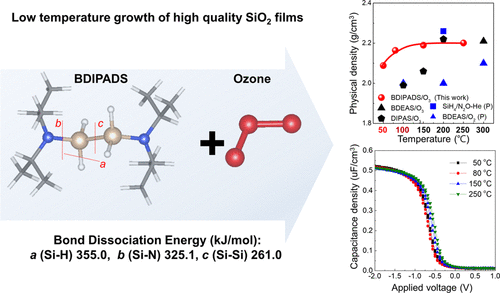当前位置:
X-MOL 学术
›
Chem. Mater.
›
论文详情
Our official English website, www.x-mol.net, welcomes your
feedback! (Note: you will need to create a separate account there.)
Thermal Atomic Layer Deposition of Device-Quality SiO2 Thin Films under 100 °C Using an Aminodisilane Precursor
Chemistry of Materials ( IF 7.2 ) Pub Date : 2019-07-22 00:00:00 , DOI: 10.1021/acs.chemmater.9b01107 Dae Hyun Kim , Han Jin Lee , Heonjong Jeong 1 , Bonggeun Shong 2 , Woo-Hee Kim , Tae Joo Park
Chemistry of Materials ( IF 7.2 ) Pub Date : 2019-07-22 00:00:00 , DOI: 10.1021/acs.chemmater.9b01107 Dae Hyun Kim , Han Jin Lee , Heonjong Jeong 1 , Bonggeun Shong 2 , Woo-Hee Kim , Tae Joo Park
Affiliation

|
SiO2 is one of the most important dielectric materials that is widely used in the microelectronics industry, but its growth or deposition requires high thermal budgets. Herein, we report a low-temperature thermal atomic layer deposition (ALD) process to fabricate SiO2 thin films using a novel aminodisilane precursor with a Si–Si bond, 1,2-bis(diisopropylamino)disilane (BDIPADS), together with ozone. To compare the film quality, ALD SiO2 films grown at various temperatures from 250 down to 50 °C were systematically investigated. Our data suggest that even without the aid of plasma-enhanced or catalyzed surface reactions, high-quality SiO2 films with relatively high growth rates, high film densities, and low impurity contents compared to conventional Si precursors can be attained through our process at a low growth temperature (∼50 °C). Chemical analyses via Auger electron spectroscopy, Fourier transform infrared spectroscopy, and X-ray photoelectron spectroscopy confirm the formation of stoichiometric SiO2 films without noticeable impurity contents of nitrogen and carbon, regardless of the growth temperature. However, low-temperature growth of the SiO2 film (≤80 °C) results in a slight ingress of SiH-related moieties during the ALD processes that is not observed at temperatures over 80 °C. Density functional theory calculations show that the Si–Si bond present in the BDIPADS precursor is easier to be oxidized compared to the Si–H bonds. Through electrical characterization of the SiO2 films grown at different temperatures, we confirm only slight degradation in the dielectric constants, leakage currents, and breakdown fields with decreasing growth temperature, which may be due to the slightly decreased film density and the increased defect density of SiH-related bonds.
中文翻译:

使用氨基二硅烷前驱体在100°C下器件质量SiO 2薄膜的热原子层沉积
SiO 2是在微电子工业中广泛使用的最重要的介电材料之一,但其生长或沉积需要较高的热预算。在这里,我们报告了一种低温热原子层沉积(ALD)工艺,该工艺使用具有Si-Si键的新型氨基乙硅烷前体,1,2-双(二异丙基氨基)乙硅烷(BDIPADS)和臭氧来制造SiO 2薄膜。为了比较薄膜质量,系统地研究了在250到50°C的各种温度下生长的ALD SiO 2薄膜。我们的数据表明,即使没有等离子体增强或催化的表面反应,高质量的SiO 2与传统的硅前驱体相比,可以通过我们的工艺在较低的生长温度(约50°C)下获得具有相对较高的生长速率,较高的膜密度和较低的杂质含量的氮化硅膜。通过俄歇电子能谱,傅里叶变换红外能谱和X射线光电子能谱进行化学分析,证实了化学计量SiO 2膜的形成,而没有明显的氮和碳杂质含量,与生长温度无关。但是,SiO 2的低温生长薄膜(≤80°C)在ALD过程中会导致SiH相关部分的轻微进入,而在80°C以上的温度下则无法观察到。密度泛函理论计算表明,与Si-H键相比,BDIPADS前体中存在的Si-Si键更容易被氧化。通过对在不同温度下生长的SiO 2薄膜的电学表征,我们确认随着生长温度的降低,介电常数,漏电流和击穿场只会轻微降低,这可能是由于薄膜密度略微降低以及缺陷密度的提高所致。。。。。。。。。。。。。。。。。。。。。。。。。。。。。。。。。。。。。。。。。。。。。。。。。。。。。。。。。。。。。。。。。。。。。。。。。。。。。。。。。。。。。。。。。。。。。。。。。。。。。。。。。。。。。。。。。。。。。。。。。。。。。。。。。。。。。。。。。。。。。。。。。。。。。。。。。。。。。。。。。。。。。。。。。。。与SiH相关的债券。
更新日期:2019-07-22
中文翻译:

使用氨基二硅烷前驱体在100°C下器件质量SiO 2薄膜的热原子层沉积
SiO 2是在微电子工业中广泛使用的最重要的介电材料之一,但其生长或沉积需要较高的热预算。在这里,我们报告了一种低温热原子层沉积(ALD)工艺,该工艺使用具有Si-Si键的新型氨基乙硅烷前体,1,2-双(二异丙基氨基)乙硅烷(BDIPADS)和臭氧来制造SiO 2薄膜。为了比较薄膜质量,系统地研究了在250到50°C的各种温度下生长的ALD SiO 2薄膜。我们的数据表明,即使没有等离子体增强或催化的表面反应,高质量的SiO 2与传统的硅前驱体相比,可以通过我们的工艺在较低的生长温度(约50°C)下获得具有相对较高的生长速率,较高的膜密度和较低的杂质含量的氮化硅膜。通过俄歇电子能谱,傅里叶变换红外能谱和X射线光电子能谱进行化学分析,证实了化学计量SiO 2膜的形成,而没有明显的氮和碳杂质含量,与生长温度无关。但是,SiO 2的低温生长薄膜(≤80°C)在ALD过程中会导致SiH相关部分的轻微进入,而在80°C以上的温度下则无法观察到。密度泛函理论计算表明,与Si-H键相比,BDIPADS前体中存在的Si-Si键更容易被氧化。通过对在不同温度下生长的SiO 2薄膜的电学表征,我们确认随着生长温度的降低,介电常数,漏电流和击穿场只会轻微降低,这可能是由于薄膜密度略微降低以及缺陷密度的提高所致。。。。。。。。。。。。。。。。。。。。。。。。。。。。。。。。。。。。。。。。。。。。。。。。。。。。。。。。。。。。。。。。。。。。。。。。。。。。。。。。。。。。。。。。。。。。。。。。。。。。。。。。。。。。。。。。。。。。。。。。。。。。。。。。。。。。。。。。。。。。。。。。。。。。。。。。。。。。。。。。。。。。。。。。。。。与SiH相关的债券。






























 京公网安备 11010802027423号
京公网安备 11010802027423号